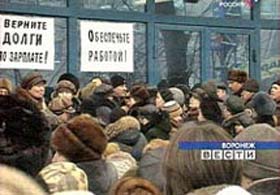Industrial Production Falling Sharply in Russia
 Russian industrial production, a strong indicator of economic health, fell 8.7 percent in November, the Kommersant newspaper reports, citing a new report from the Ministry of Economic Development. According to the findings, manufacturing output dropped 10.3 percent; energy, gas and water production and distribution fell 9.3 percent; mining operations, excluding a seasonal effect, fell .6 percent.
Russian industrial production, a strong indicator of economic health, fell 8.7 percent in November, the Kommersant newspaper reports, citing a new report from the Ministry of Economic Development. According to the findings, manufacturing output dropped 10.3 percent; energy, gas and water production and distribution fell 9.3 percent; mining operations, excluding a seasonal effect, fell .6 percent.
If seasonal factors are not taken into account, production has been declining for three months in a row. A Government source said that output in certain sectors, including coking coal, paper pulp and machinery had fallen more than 30 percent in November 2008 as compared with November 2007. “Only sectors tied in with government contracts saw appreciable growth: the manufacture of locomotives and turbine generators,” the source said.
The official estimates of 1.9 percent growth in industrial production for 2008 indicate that December should be even worse. Output would need to fall 19 percent for the month to meet the yearly prognosis. In practical terms, this suggests that key sectors that have already seen heavy losses should brace for continued problems.
Figures released by Rosstat, Russia’s statistical agency, showed that the fall in production was historically significant. If the slowdown continues at the same pace in December, the fall in industrial production will be deeper than that felt in the 1998 financial crisis. The November 2008 figures correspond with falling output at the start of 1999, when the crisis was at its peak.
Ordinary Russians were also feeling the effects of the crisis, and public opinion polls showed a rising dissatisfaction in the measures taken by authorities. As the Vedomosti newspaper reported on December 15th, citing the Public Opinion Foundation (FOM), 39 percent of the country do not have faith in the country’s leadership.
The survey was conducted in 68 regions that encompass 91 percent of Russia’s population. 34 thousand respondents were questioned from November 14th to the 25th.
42 percent of participants thought that the economy was in crisis. 26 percent noted a worsened situation in their region, while 36 percent saw construction projects being stopped. 20 to 33 percent, depending on the social group, feared they may not be able to find a job, while 25-33 expected to be laid off in the near future. 37-43 percent expected problems at the workplace.
Of those questioned, 39 percent said they felt a stronger sense of protest and dissatisfaction with authorities. In regions with heavy industrial production, the number went to 54 percent.
Alexander Orlov, FOM’s president, said that disaffection was identical across social groups, and that it was targeted primarily at local authorities.
Regions were rated on their dissatisfaction with authorities, then divided into three groups: calm, medium, and alarming. The most alarming regions were the Republic of Tatarstan, and the Yaroslav, Kursk and Omsk oblasts (regions). Moscow and St. Petersburg are also in the “alarming” category.
